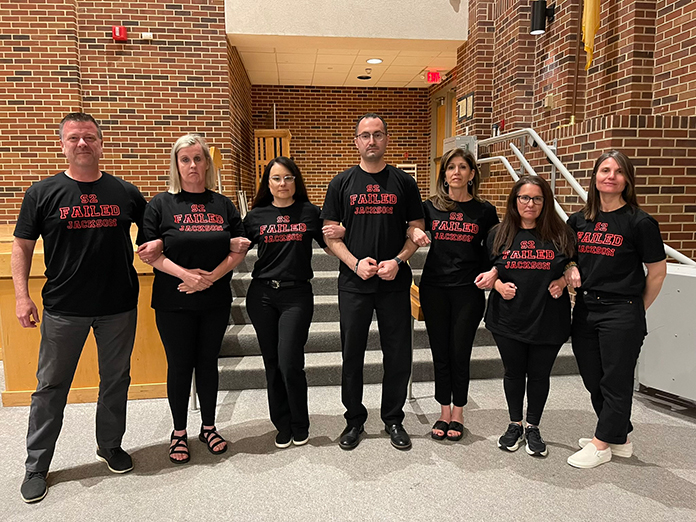
JACKSON – Dressed in black T-shirts with writing that proclaimed New Jersey had failed the school district and schools around the state, the Board of Education stood united during a public forum concerning its proposed spending plan.
Parents, residents, students and school district staff came out to a special Board of Education meeting held at the Fine Arts Center of Jackson Memorial High School that covered details about the ongoing challenges of the school district’s loss of $22.4 million in state aid over the past seven years.
The school district is facing a $25 million deficit in the 2024-25 school year, and according to officials, the Board is powerless to close that gap without lowering the bar on educational quality provided to students.
Officials expressed that they were looking for at least a short-term solution which could only be provided by the State Legislature and State Department of Education who caused the problem. The answer would be for those agencies to provide the district with grants, not loans, to close the deficit and to end the S-2 state aid school funding formula and create one that is transparent and equitable for all school districts.
S-2 was the name of the bill that crafted the school funding formula many years ago.
Officials said Jackson is spending about $3,500 per student while Newark is spending around $30,000 per student.
Superintendent Nicole Pormilli explained some of the cuts that would need to be made to close the $25 million deficit. They included eliminating 27 more positions (bringing the total to 242 over the past seven years), increasing class sizes to 30 in the elementary schools and 35 to 40 in the middle schools and high schools, closing schools and she clarified that she was speaking in the plural tense), eliminating athletics altogether, cutting band, theater and clubs altogether, eliminating Air Force ROTC, eliminating courtesy busing, eliminating late buses, and foregoing any facilities improvements.
She noted the PowerPoint presentation title of, “Mission Impossible” as being appropriately named.
Present for the forum was Carole Knopp-Morris, the district’s fiscal monitor, who was assigned to the district after it had applied for a loan to close the still-unclosed $10 million 2023-24 budget gap.
School districts were informed that they would not be permitted to seek a state loan for the 2024-2025 school year.
Knopp-Morris will be paid by the school district, up to $160,000 for her services. She was directly asked whether Jackson could satisfy the state mandate to provide a thorough and efficient education if it had to follow through on its $25 million in cuts.
She stated that the school district’s funding shortfall problem was a revenue crisis, not a spending crisis. And that there were a number of factors that went into it, calling it a “perfect storm.” She singled out inflation and the COVID-19 pandemic.
The State Monitor added, “there has been, to my knowledge, no mismanagement of any kind and the appropriate cuts have been made.”
Board members and administrators acknowledged that the district was suffering from a revenue crisis and expressed that the only solution would be for Governor Phil Murphy, Acting Education Commissioner Kevin Dehmer and state legislators to take action and restore funds..
Board President Giuseppe Palmieri said, “this is a very tough time in our district. It is wonderful that parents and staff came to this meeting to show their support of our district.”
Superintendent Pormilli joined members of the Board in repeating much of what was included in a joint letter of the Board sent to Governor Murphy and Dehmer which noted that the school district was “fiscally responsible. We have had two outside auditors look at our financial reporting, along with the Ocean County Superintendent and our state-appointed monitor. All four have concluded that we have been fiscally responsible prior to and throughout the S-2 funding period. Yet here we are in a critical, unsustainable position.”
Resident Jonathan Myers asked Knopp-Morris to describe the S-2 funding formula and she replied that the court hadn’t released the formula as it was the subject of a lawsuit by Jackson and several other districts – so “I don’t have it.”
When asked if she felt it was fair for the state to refuse to release information about the funding formula on the grounds the data was “proprietary,” she answered “No, but I wasn’t in on the reasons for that or the (court) decision. That’s not passing the buck, I just don’t know the answer to the question.”
Pormilli clarified that the case had concluded, and that school districts received a formula that was “difficult to understand. We asked for numbers that would be plugged into that formula and did not receive them, so at this point the case is over.”
Myers asked whether there would be any follow-up to make the state account for how it was using taxpayers’ money?

The superintendent replied that Jackson and the other districts already appealed once, and would have to do so again, “which, as you can imagine, would cost districts money.”
“Considering we have lost tens of millions of dollars. I implore the school budget board to push for that please,” Myers added.
Jackson administrators said they postponed curriculum updates that they stated were “imperative to our students’ education, and we have eliminated certain sports, coaches and co-curriculars. The district has also postponed much-needed facility investments and struggle to continue to assist students through learning losses.”
The administration has also been looking at mental health and academic needs that have also increased. The Board maintains that the district is drastically underfunded based on the Adequacy Budget calculated by the NJ Department of Education, putting the figure at $23,783,329 below adequacy.
Palmeri noted, “we are frustrated that the state’s own guidelines for a district of our size are being diminished by the state itself. In addition, we were bracing for a $806,460 cut in our state aid in this last year of S-2 and were notified in March that the cut will now be $4.4 million.”
The district’s transportation, security and special education aid which has been frozen at 2017-2018 levels – are drastically underfunded, officials said. Transportation Aid is frozen at $601,355 and should be $7,735,206; security aid is frozen at $854,977 and should be $1,882,669; while special education remains frozen at $5,211,500 and should be at $7,427,591.
State Help: Too Little, Too Late?
Shortly after the meeting, Governor Phil Murphy signed two bills that potentially help the district and many like it, but don’t solve the entire problem.
The first bill (A-4161) establishes a Stabilized School Budget Aid Grant Program. Districts can apply for grants equal to 45% of how much of their aid was cut for the 2024-2025 school year. Districts across New Jersey will compete for a pool of $44.7 million.
This bill also allows certain districts to request permission to increase taxes beyond the 2% cap imposed upon them years ago.
The second bill (A-4059) authorizes the Commissioner of Education to permit certain school districts experiencing a reduction in state aid to submit budgets no later than five days following the enactment of the FY2025 appropriations act. In simpler terms, a school district would have until the state budget is finalized before they finish their own budget. The state fiscal year is from July 1 through June 30, so this means it would be the end of June.
Chris Lundy contributed to this story






